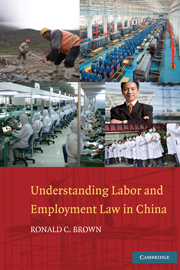Book contents
- Frontmatter
- Contents
- Preface
- Acknowledgments
- Understanding Labor and Employment Law in China
- PART I UNDERSTANDING CHINA'S REGULATION OF THE WORKPLACE
- PART II EMPLOYMENT RELATIONSHIPS
- PART III HIRING AND EMPLOYMENT PRACTICES
- PART IV WORKING CONDITIONS, WAGES, AND HOURS
- PART V EMPLOYEE BENEFITS: LEAVES, MEDICAL, MATERNITY, WORK-RELATED, UNEMPLOYMENT, AND PENSION INSURANCE
- 11 Mandated and Nonmandated Employee Benefits
- PART VI DISCIPLINE AND TERMINATION UNDER EMPLOYMENT AGREEMENTS
- PART VII RIGHTS, REMEDIES, AND MULTIPLE FORUMS
- Appendix
- Index
11 - Mandated and Nonmandated Employee Benefits
Published online by Cambridge University Press: 22 January 2010
- Frontmatter
- Contents
- Preface
- Acknowledgments
- Understanding Labor and Employment Law in China
- PART I UNDERSTANDING CHINA'S REGULATION OF THE WORKPLACE
- PART II EMPLOYMENT RELATIONSHIPS
- PART III HIRING AND EMPLOYMENT PRACTICES
- PART IV WORKING CONDITIONS, WAGES, AND HOURS
- PART V EMPLOYEE BENEFITS: LEAVES, MEDICAL, MATERNITY, WORK-RELATED, UNEMPLOYMENT, AND PENSION INSURANCE
- 11 Mandated and Nonmandated Employee Benefits
- PART VI DISCIPLINE AND TERMINATION UNDER EMPLOYMENT AGREEMENTS
- PART VII RIGHTS, REMEDIES, AND MULTIPLE FORUMS
- Appendix
- Index
Summary
Social Security System
China's social security “safety net” system comprises five insurance benefit programs: medical, maternity, work-related injury, unemployment, and pension. Most employee benefits are mandated by law and are administered by government programs. A new national law on social insurance is now in draft form and is expected to be passed in late 2009. These include social insurance programs, housing funds, labor union funding, and certain leave policies for employees, such as holiday leave, home leave and/or annual leave, and medical leave. Employees may also receive nonmandated benefits that are discretionary or negotiated and included in contracts, such as seniority, merit increases, bonuses, parking, travel, and special allowances, such as for hazardous work.
Mandated social security benefits programs are nationally devised and locally implemented. Medical insurance is available under a unified insurance program in which both employers and employees contribute a certain percentage of payroll and individual income, respectively, into a general fund consisting of a pooled fund and a personal account. Maternity insurance is employer funded and provides financial support for the mother during an authorized time period. Employer-funded occupational (work-related) injury insurance is also provided under local government systems and is funded by employer contributions. The unemployment and pension programs are a massive undertaking still taking shape, but every year additional millions of employees come under their protective umbrella. Both programs are funded by joint contributions of the employer and employee.
- Type
- Chapter
- Information
- Understanding Labor and Employment Law in China , pp. 135 - 148Publisher: Cambridge University PressPrint publication year: 2009

